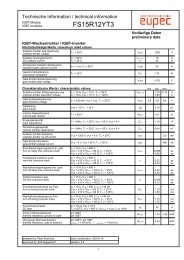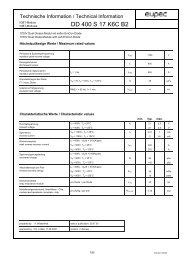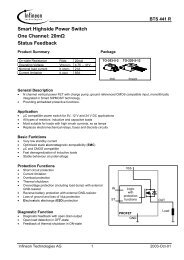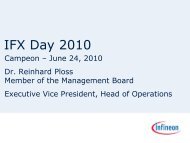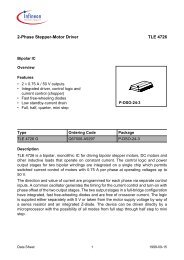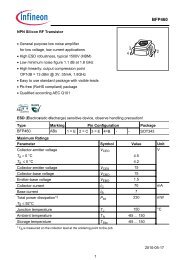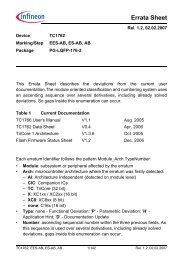TC1765_ds_v12 (TC1765_ds_v12_1202.pdf) - Infineon
TC1765_ds_v12 (TC1765_ds_v12_1202.pdf) - Infineon
TC1765_ds_v12 (TC1765_ds_v12_1202.pdf) - Infineon
- TAGS
- infineon
- www.infineon.com
You also want an ePaper? Increase the reach of your titles
YUMPU automatically turns print PDFs into web optimized ePapers that Google loves.
Preliminary<br />
<strong>TC1765</strong><br />
PLL Parameters<br />
Note: All PLL characteristics defined on this and the next page are guaranteed by design<br />
characterization.<br />
V SS = 0 V; V DD = 2.30 to 2.75 V; T A = -40 °C to +125 °C;<br />
Parameter Symbol Limit Values Unit<br />
min. max.<br />
Accumulated jitter DN see Figure 29 –<br />
VCO frequency range fVCO 150 200 MHz<br />
PLL base frequency fPLLBASE 40 130 MHz<br />
PLL lock-in time tL – 200 µs<br />
Phase Locked Loop Operation<br />
When PLL operation is enabled and configured (see Figure 16 and Page 51), the PLL<br />
clock fVCO (and with it the system clock fSYS ) is constantly adjusted to the selected<br />
frequency. The relation between fVCO and fSYS is defined by: fVCO =K× fSYS. The PLL<br />
causes a jitter of fSYS and CPUCLK/ECOUT, which is directly derived from fSYS and<br />
which has its frequency.<br />
The following two formulas define the (absolute) approximate maximum value of jitter DN in ns dependent on the K-factor, the system clock frequency fSYS in MHz, and the<br />
number P of consecutive fSYS perio<strong>ds</strong>.<br />
for P < 23.5<br />
K<br />
for P > 23.5<br />
K<br />
D N [ns] = ±<br />
D N [ns] = ±<br />
3.9<br />
f SYS [MHz] × P + 1.2<br />
With rising number P of clock cycles the maximum jitter increases linearly up to a value<br />
of P that is defined by the K-factor of the PLL. Beyond this value of P the maximum<br />
accumulated jitter remains at a constant value. Further, a lower system clock frequency<br />
fSYS results in a higher maximum jitter.<br />
Figure 29 gives an example for typical jitter curves with K =4@40MHz,<br />
K = 6 @33 MHz, and K = 8@20/25 MHz.<br />
91.7<br />
f SYS [MHz] × K<br />
+ 1.2<br />
Data Sheet 74 V1.2, 2002-12<br />
[1]<br />
[2]





